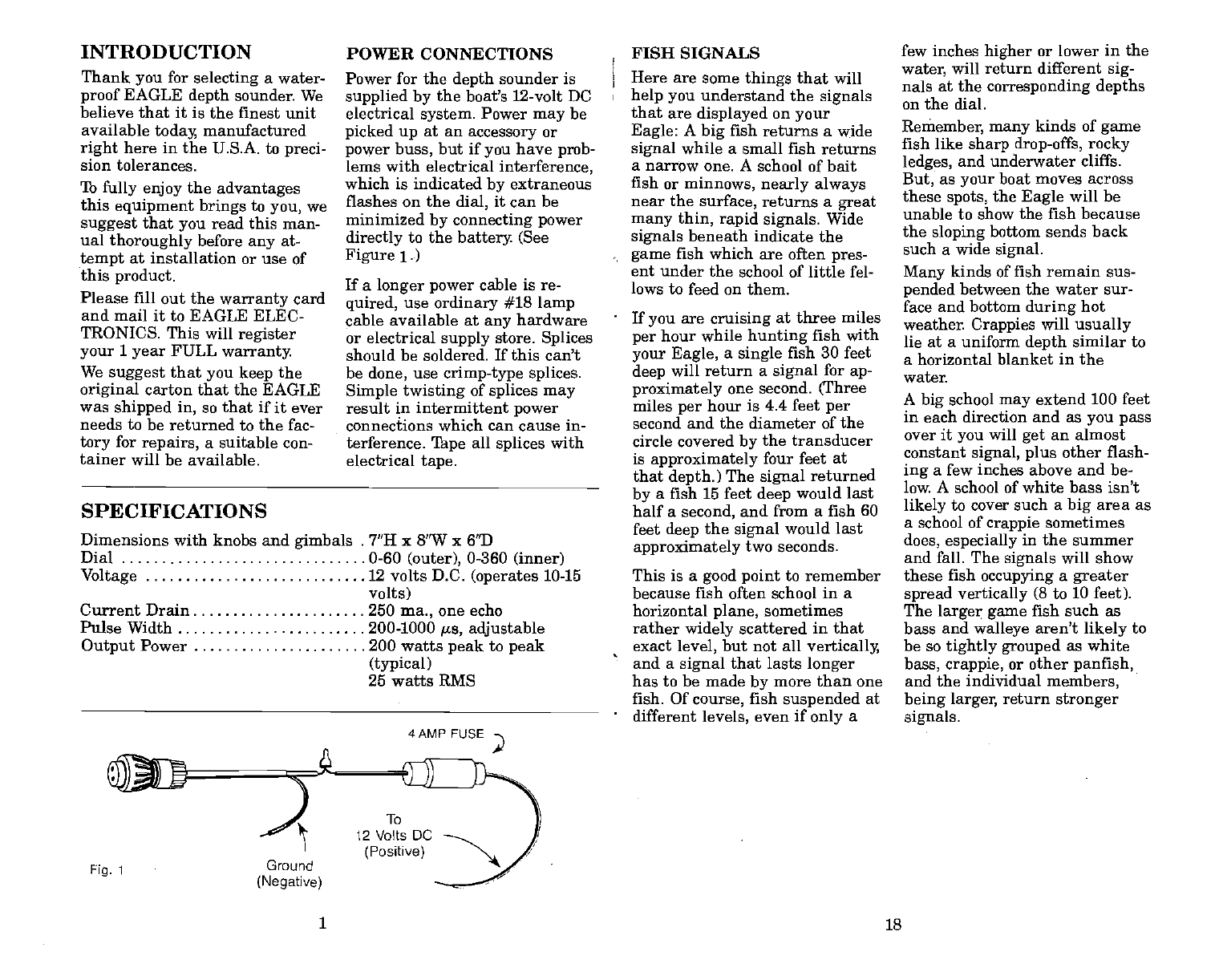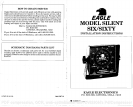
INTRODUCTION
Thank
you
for
selecting
a water-
proof
EAGLE
depth
sounder. We
believe that it is the finest unit
available
today,
manufactured
right
here in
the U.S.A. to
preci-
sion
tolerances.
lb
fully enjoy
the
advantages
this
equipment
brings
to
you,
we
suggest
that
you
read this man-
ual
thoroughly
before
any
at-
tempt
at installation or use
of
this
product.
Please fill out the
warranty
card
and mail it to EAGLE ELEC-
TRONICS. This will
register
your
1
year
FULL
warranty.
We
suggest
that
you keep
the
original
carton that the EAGLE
was
shipped in,
so that if it
ever
needs to be returned to the fac-
tory
for
repairs,
a suitable con-
tainer will be available.
POWER CONNECTIONS
Power for the
depth
sounder is
supplied by
the boat's 12-volt DC
electrical
system.
Power
may
be
picked up
at an
accessory
or
power buss,
but if
you
have
prob-
lems with electrical
interference,
which is indicated
by
extraneous
flashes on the
dial,
it can be
minimized
by connecting power
directly
to the
battery
(See
Figure
1.)
If a
longer power
cable is re-
quired,
use
ordinary
#18
lamp
cable available at
any
hardware
or electrical
supply
store.
Splices
should be soldered. If this can't
be
done,
use
crimp-type splices.
Simple twisting
of
splices may
result in intermittent
power
connections which can cause in-
terference.
'Ihpe
all
splices
with
electrical
tape.
FISH SIGNALS
Here are some
things
that will
help you
understand the
signals
that are
displayed
on
your
Eagle:
A
big
fish returns a wide
signal
while a small fish returns
a
narrow one. A school of bait
fish
or
minnows,
nearly always
near the
surface,
returns a
great
many thin, rapid
signals.
Wide
signals
beneath
indicate the
game
fish which are often
pres-
ent under
the school of little fel-
lows
to feed on them.
If
you
are
cruising
at
three miles
per
hour while
hunting
fish with
your Eagle,
a
single
fish 30 feet
deep
will return
a
signal
for
ap-
proximately
one second.
(Three
miles
per
hour is 4.4 feet
per
second and the diameter of the
circle covered
by
the transducer
is
approximately
four feet at
that
depth.)
The
signal
returned
by
a fish 15 feet
deep
would
last
half a
second,
and from a fish 60
feet
deep
the
signal
would
last
approximately
two seconds.
This is a
good point
to remember
because fish often school in a
horizontal
plane,
sometimes
rather
widely
scattered in that
exact
level,
but not all
vertically,
and a
signal
that lasts
longer
has to be made
by
more than one
fish. Of
course,
fish
suspended
at
different
levels,
even if
only
a
few inches
higher
or lower in the
water,
will return different
sig-
nals at the
corresponding depths
on the dial.
Remember, many
kinds of
game
fish like
sharp drop-offs, rocky
ledges,
and underwater cliffs.
But,
as
your
boat moves across
these
spots,
the
Eagle
will be
unable to show the fish because
the
sloping
bottom sends back
such a wide
signal.
Many
kinds of fish remain sus-
pended
between the water sur-
face and bottom
during
hot
weather.
Crappies
will
usually
lie at a uniform
depth
similar to
a horizontal blanket in the
water.
A
big
school
may
extend 100 feet
in each direction and as
you pass
over it
you
will
get
an almost
constant
signal, plus
other flash-
ing
a few inches above and be-
low. A school of white bass isn't
likely
to cover such a
big
area as
a school of
crappie
sometimes
does,
especially
in the summer
and fall. The
signals
will show
these fish
occupying
a
greater
spread vertically
(8
to 10
feet).
The
larger game
fish such as
bass and
walleye
aren't
likely
to
be so
tightly grouped
as white
bass,
crappie,
or other
panfish,
and the individual
members,
being larger,
return
stronger
signals.
1 18
SPECIFICATIONS
Dimensions with knobs and
gimbals
. 711 x 8W x 61)
Dial 0-60
(outer),
0-360
(inner)
Voltage
12 volts D.C.
(operates
10-15
volts)
Current
Drain 250
ma.,
one echo
Pulse Width 200-1000
cs,
adjustable
Output
Power 200 watts
peak
to
peak
(typical)
25 wafts RMS
4AMP FUSE
Fig.
1
To
12 Volts DC
(Positive)
Ground
(Negative)
PDF compression, OCR, web-optimization with CVISION's PdfCompressor












